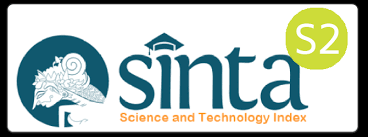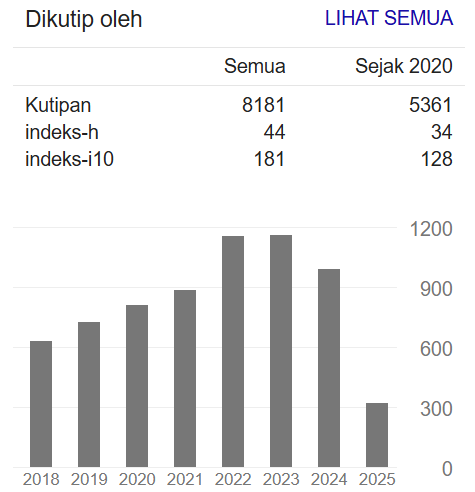EFFECTIVENESS OF STATIN AND EZETIMIBE COMBINATION ON ATHEROSCLEROTIC PLAQUE IN PATIENTS WITH CORONARY HEART DISEASE
DOI:
https://doi.org/10.34011/jmp2k.v35i3.3198Keywords:
ezetimibe, penghambat HMG-CoA reduktase, penyakit jantung koroner, plak aterosklerosis, statinAbstract
Penyakit jantung koroner mengacu pada kondisi penyumbatan pembuluh darah arteri yang dikenal dengan istilah aterosklerosis. Statin bekerja dengan mengurangi produksi kolesterol di hati serta menjaga stabilisasi plak pada pasien dengan penyakit jantung koroner. Namun demikian pemberian statin tidak dapat ditoleransi dengan baik pada pasien tertentu, sehingga dipertimbangkan penggunaan kombinasi statin dengan ezetimibe. Tinjauan artikel ini bertujuan untuk mengetahui efektivitas kombinasi statin dan ezetimibe terhadap plak aterosklerosis pada pasien dengan penyakit jantung koroner. Penelusuran pustaka dilakukan menggunakan basis data PubMed dan EBSCO (MEDLINE Ultimate) pada bulan Februari 2025 dengan menggunakan kata kunci “Ezetimibe”, “Hydroxymethylglutaryl-CoA Reductase Inhibitors”,“Atherosclerotic Plaque” dan “Coronary Artery Disease”. Artikel dipilih berdasarkan kriteria inklusi yaitu artikel berbahasa Inggris, diterbitkan dalam sepuluh tahun terakhir, penelitian pada manusia, dan merupakan randomized controlled trial pada pasien jantung koroner dengan atau tanpa penyakit penyerta. Kriteria eksklusi meliputi: tinjauan/review, studi protokol, editorial, tinjauan sistematis dan meta analisis, dan topik/hasil yang tidak relevan. Penelusuran awal menghasilkan 34 artikel dengan 10 duplikasi dan 14 kriteria eksklusi, sehingga diperoleh 10 artikel penelitian yang berfokus di Jepang, Korea, dan Cina. Hasil tinjauan artikel menunjukkan bahwa kombinasi statin dengan ezetimibe lebih efektif dalam menurunkan low density lipoprotein-cholesterol (LDL-C), mengurangi respon inflamasi, serta menghasilkan regresi plak aterosklerosis yang lebih besar dibandingkan monoterapi statin. Dengan demikian, penggunaan kombinasi statin dosis rendah hingga sedang dan ezetimibe dapat menjadi terapi pilihan bagi pasien dengan penyakit jantung koroner yang berisiko tinggi.
References
J. George, “Pathophysiology of Coronary Artery Disease,” in Interventional Cardiology Imaging: An Essential Guide, A. E. Abbas, Ed., London: Springer London, 2015, pp. 29–46. doi: 10.1007/978-1-4471-5239-2_3.
World Health Organization, “Cardiovascular diseases (CVDs) WHO.int. https://www.who.int/news-room/fact-sheets/detail/cardiovascular-diseases-(cvds) (accessed Mar, 22, 2025).”
Badan Penelitian dan Pengembangan Kesehatan, “Laporan Nasional Riskesdas 2018 ,” Kementerian Kesehatan Republik Indonesia, 2019.
M. R. Chilbert, D. Vanduyn, S. Salah, C. M. Clark, and Q. Ma, “Combination Therapy of Ezetimibe and Rosuvastatin for Dyslipidemia: Current Insights,” 2022, Dove Medical Press Ltd. doi: 10.2147/DDDT.S332352.
A. M. Ferreira and P. Marques da Silva, “Defining the Place of Ezetimibe/Atorvastatin in the Management of Hyperlipidemia,” American Journal of Cardiovascular Drugs, vol. 17, no. 3, pp. 169–181, 2017, doi: 10.1007/s40256-016-0205-0.
W. Abed, M. Abujbara, A. Batieha, and K. Ajlouni, “Statin Induced Myopathy Among Patients Attending the National Center for Diabetes, Endocrinology, & Genetics,” Annals of Medicine and Surgery, vol. 74, Feb. 2022, doi: 10.1016/j.amsu.2022.103304.
C. B. Newman et al., “Statin Safety and Associated Adverse Events: A Scientific Statement from the American Heart Association,” Arterioscler Thromb Vasc Biol, vol. 39, no. 2, pp. E38–E81, Feb. 2019, doi: 10.1161/ATV.0000000000000073.
U. Aiman, A. Najmi, and R. A. Khan, “Statin induced diabetes and its clinical implications,” 2014, Medknow Publications. doi: 10.4103/0976-500X.136097.
M. Laakso and L. Fernandes Silva, “Statins and risk of type 2 diabetes: mechanism and clinical implications,” 2023, Frontiers Media SA. doi: 10.3389/fendo.2023.1239335.
E. Han et al., “Comparison between atorvastatin and rosuvastatin in renal function decline among patients with diabetes,” Endocrinology and Metabolism, vol. 32, no. 2, pp. 274–280, Jun. 2017, doi: 10.3803/EnM.2017.32.2.274.
Y. N. Lamb, “Rosuvastatin/Ezetimibe: A Review in Hypercholesterolemia,” American Journal of Cardiovascular Drugs, vol. 20, no. 4, pp. 381–392, 2020, doi: 10.1007/s40256-020-00421-1.
K. Tsujita et al., “Impact of Dual Lipid-Lowering Strategy With Ezetimibe and Atorvastatin on Coronary Plaque Regression in Patients With Percutaneous Coronary Intervention The Multicenter Randomized Controlled PRECISE-IVUS Trial,” 2015.
K. Tsujita et al., “Lipid profile associated with coronary plaque regression in patients with acute coronary syndrome: Subanalysis of PRECISE-IVUS trial,” Atherosclerosis, vol. 251, pp. 367–372, Aug. 2016, doi: 10.1016/j.atherosclerosis.2016.05.025.
K. Tsujita et al., “Synergistic effect of ezetimibe addition on coronary atheroma regression in patients with prior statin therapy: Subanalysis of PRECISE-IVUS trial,” Eur J Prev Cardiol, vol. 23, no. 14, pp. 1524–1528, Sep. 2016, doi: 10.1177/2047487316655465.
K. Fujisue et al., “Impact of statin-ezetimibe combination on coronary atheroma plaque in patients with and without chronic kidney disease — Sub-analysis of PRECISE-IVUS trial,” Int J Cardiol, vol. 268, pp. 23–26, Oct. 2018, doi: 10.1016/j.ijcard.2018.04.051.
X. Wang, X. Zhao, L. Li, H. Yao, Y. Jiang, and J. Zhang, “Effects of Combination of Ezetimibe and Rosuvastatin on Coronary Artery Plaque in Patients with Coronary Heart Disease,” Heart Lung Circ, vol. 25, no. 5, pp. 459–465, May 2016, doi: 10.1016/j.hlc.2015.10.012.
J. H. Lee et al., “Early effects of intensive lipid-lowering treatment on plaque characteristics assessed by virtual histology intravascular ultrasound,” Yonsei Med J, vol. 57, no. 5, pp. 1087–1094, Sep. 2016, doi: 10.3349/ymj.2016.57.5.1087.
Y. Ueda et al., “Effect of ezetimibe on stabilization and regression of intracoronary plaque: The ZIPANGU study,” Circulation Journal, vol. 81, no. 11, pp. 1611–1619, 2017, doi: 10.1253/circj.CJ-17-0193.
J. Wang, X.-B. Ai, F. Wang, Y.-W. Zou, L. Li, and X.-L. Yi, “Efficacy of ezetimibe combined with atorvastatin in the treatment of carotid artery plaque in patients with type 2 diabetes mellitus complicated with coronary heart disease,” Int Angiol, vol. 36, no. 5, pp. 467–473, 2017, doi: 10.23736/s0392-9590.17.03818-4.
P. C. Oh et al., “Effect of Atorvastatin (10 mg) and Ezetimibe (10 mg) Combination Compared to Atorvastatin (40 mg) Alone on Coronary Atherosclerosis,” American Journal of Cardiology, vol. 154, pp. 22–28, Sep. 2021, doi: 10.1016/j.amjcard.2021.05.039.
Y. Nakano et al., “Association between Serum Oxysterols and Coronary Plaque Regression during Lipid-Lowering Therapy with Statin and Ezetimibe: Insights from the CuVIC Trial,” J Atheroscler Thromb, vol. 30, no. 8, pp. 907–918, 2023, doi: 10.5551/jat.63507.
E. Shlofmitz, C. C. Kerndt, A. Parekh, and N. Khalid, “Intravascular Ultrasound,” StatPearls [Internet]. Treasure Island (FL): StatPearls Publishing; 2025 Jan-. Available from: https://www.ncbi.nlm.nih.gov/books/NBK537019/ (accessed on Mar 24,2025).
S.-Y. Chen, C. Chen, L. Ding, H. Liu, T. Yang, and J. Wu, “Comparison Between Carotid Ultrasound and Digital Subtraction Angiography in the Diagnosis of Carotid Artery Stenosis in Patients with Cerebral Infarction,” International Journal of Morphology, vol. 40, pp. 1560–1565, 2022.
O. Sizar, A. Nassereddin, and R. Talati, “Ezetimibe,” Treasure Island (FL): StatPearls Publishing. NIH National Library of Medicine. https://www.ncbi.nlm.nih.gov/books/NBK532879/ (accessed Mar, 22, 2025).
Y. Akiyama et al., “Association of Serum Oxysterols with Cholesterol Metabolism Markers and Clinical Factors in Patients with Coronary Artery Disease: A Covariance Structure Analysis,” Nutrients, vol. 15, no. 13, p. 2997, Jun. 2023, doi: 10.3390/nu15132997.
T. Banait, A. Wanjari, V. Danade, S. Banait, and J. Jain, “Role of High-Sensitivity C-reactive Protein (Hs-CRP) in Non-communicable Diseases: A Review,” Cureus, Oct. 2022, doi: 10.7759/cureus.30225.
H. Ii, N. Hontani, I. Toshida, M. Oka, T. Sato, and S. Akiba, “Group IVA Phospholipase A2-Associated Production of MMP-9 in Macrophages and Formation of Atherosclerotic Lesions,” Biol Pharm Bull, vol. 31, no. 3, pp. 363–368, 2008, doi: 10.1248/bpb.31.363.
J. Li, Y. Dong, T. Wu, and N. Tong, “Differences between Western and Asian type 2 diabetes patients in the incidence of vascular complications and mortality: A systematic review of randomized controlled trials on lowering blood glucose,” J Diabetes, vol. 8, no. 6, pp. 824–833, Nov. 2016, doi: 10.1111/1753-0407.12361.
T. Hiro et al., “Rationale and design of a randomized clinical study to investigate the effect of ezetimibe, a cholesterol absorption inhibitor, on the regression of intracoronary plaque evaluated by non-obstructive angioscopy and ultrasound: The ZIPANGU study,” J Cardiol, vol. 64, no. 6, pp. 501–507, Dec. 2014, doi: 10.1016/j.jjcc.2014.02.026.
B. W. Karlson, O. Wiklund, M. K. Palmer, S. J. Nicholls, P. Lundman, and P. J. Barter, “Variability of low-density lipoprotein cholesterol response with different doses of atorvastatin, rosuvastatin, and simvastatin: results from VOYAGER,” Eur Heart J Cardiovasc Pharmacother, vol. 2, no. 4, pp. 212–217, Oct. 2016, doi: 10.1093/ehjcvp/pvw006.
R. Puri et al., “Long-term effects of maximally intensive statin therapy on changes in coronary atheroma composition: insights from SATURN,” Eur Heart J Cardiovasc Imaging, vol. 15, no. 4, pp. 380–388, Apr. 2014, doi: 10.1093/ehjci/jet251.
M. A. Jose, S. Anandkumar, M. P. Narmadha, and M. Sandeep, “A comparative effect of atorvastatin with other statins in patients of hyperlipidemia,” Indian J Pharmacol, vol. 44, no. 2, pp. 261–263, Apr. 2012, doi: 10.4103/0253-7613.93864.
Y. J. Lee et al., “Rosuvastatin versus atorvastatin treatment in adults with coronary artery disease: secondary analysis of the randomised LODESTAR trial,” BMJ, vol. 383, p. e075837, Oct. 2023, doi: 10.1136/bmj-2023-075837.
Downloads
Published
How to Cite
Issue
Section
Citation Check
License
Copyright (c) 2025 Herdina Mayangsari Sumedhi, Neily Zakiyah, Triwedya Indra Dewi, Rano Kurnia Sinuraya, Irma Melyani Puspitasari

This work is licensed under a Creative Commons Attribution-ShareAlike 4.0 International License.




